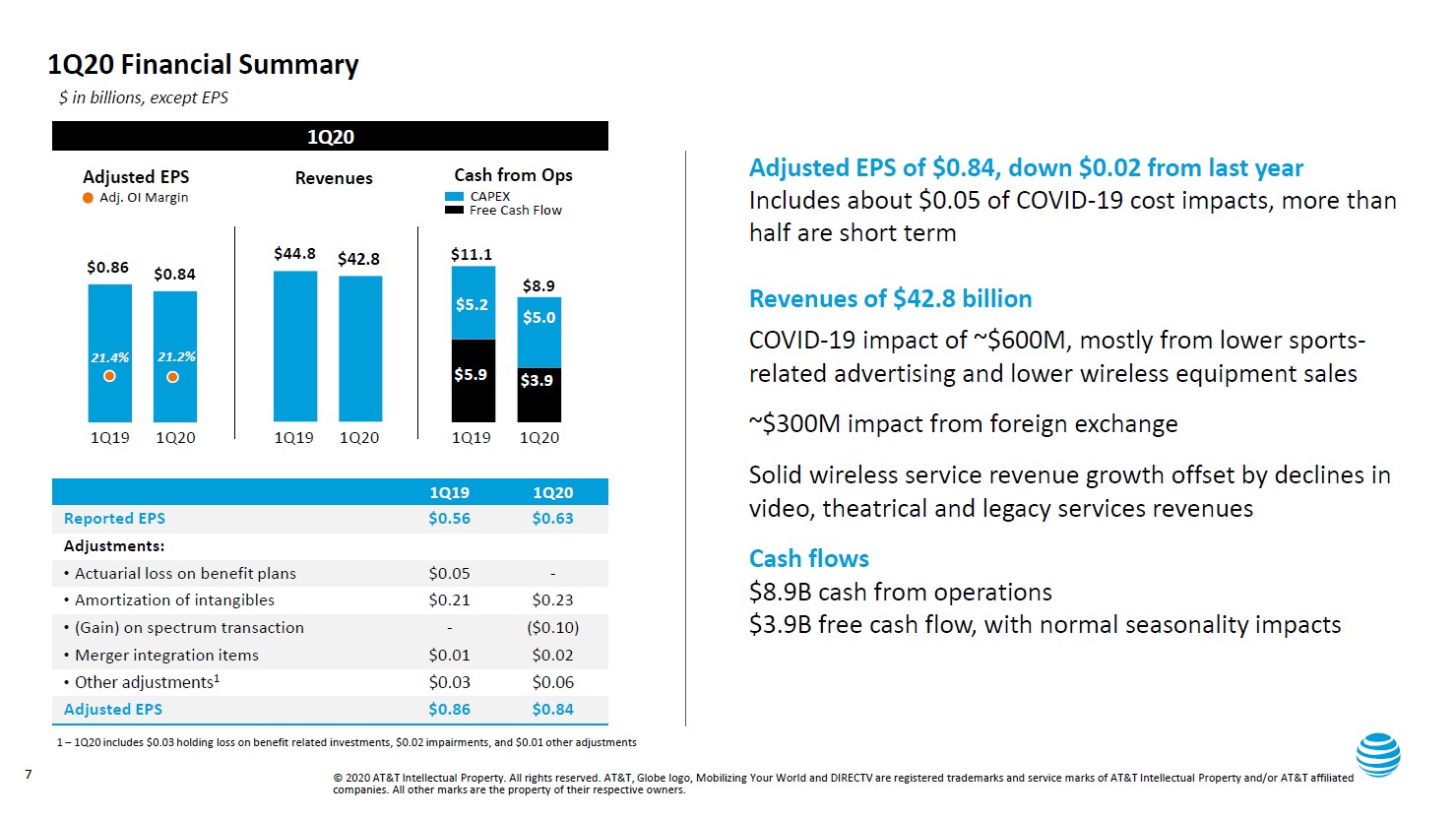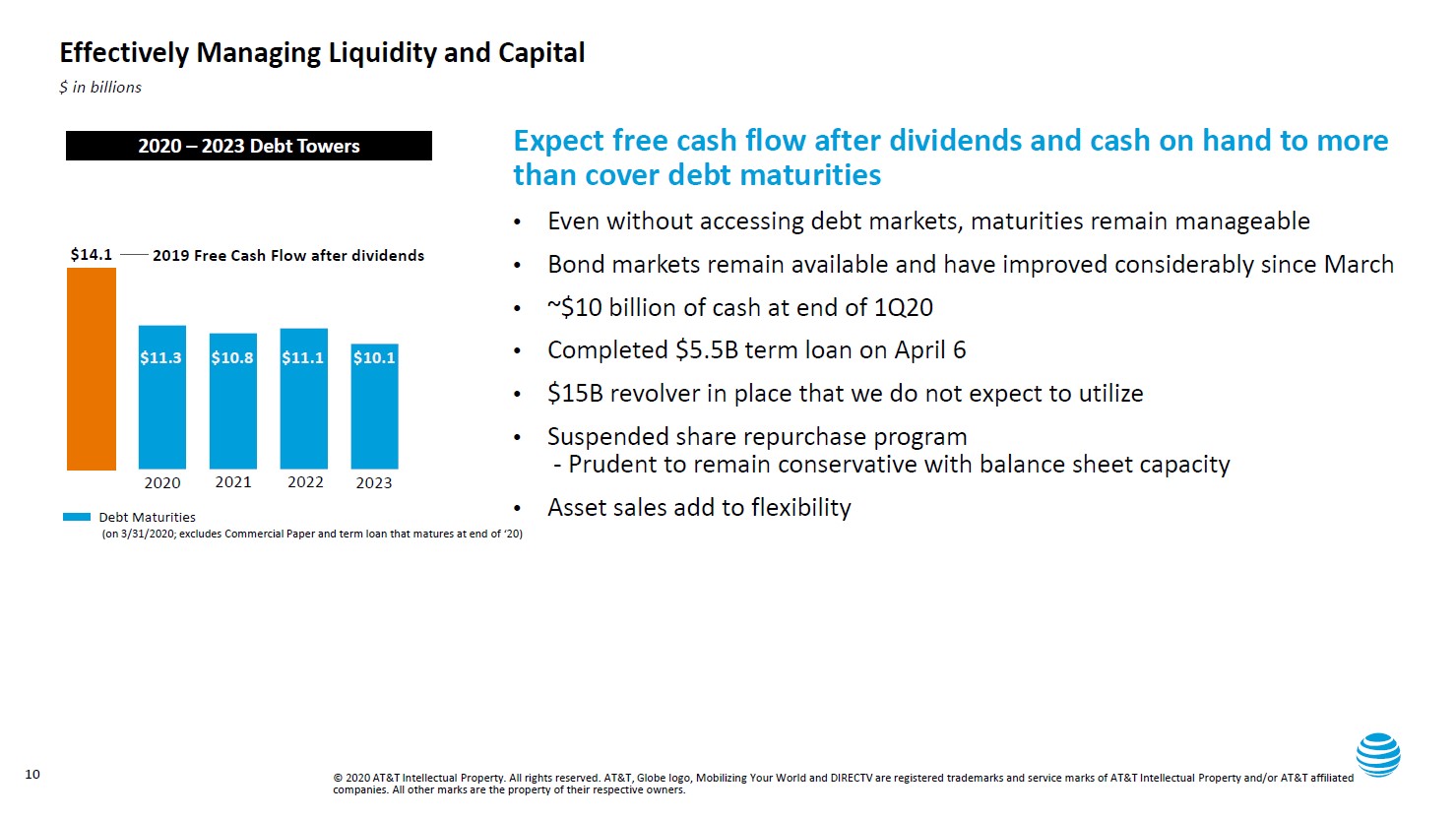Member LoginDividend CushionValue Trap |
AT&T Has the Potential Resilience to Ride Out the Storm With Its Dividend Intact
publication date: Apr 22, 2020
|
author/source: Callum Turcan
Image Source: AT&T Inc – First Quarter 2020 Earnings IR Presentation By Callum Turcan High Yield Dividend Newsletter portfolio holding AT&T Inc (T) reported first-quarter 2020 earnings on April 22 that missed consensus top- and bottom-line estimates; however, management noted right off the bat that the ongoing coronavirus (‘COVID-19’) pandemic shaved $0.05 in EPS off of AT&T’s performance. The cancellation of the 2020 NCAA Division I Men's Basketball Tournament and ongoing losses of its premium TV subscribers (a product of structural declines at DirecTV) weighed on AT&T’s results last quarter. Shares of T yield ~7.1% as of this writing. AT&T continued to generate meaningful free cash flows, keeping various headwinds in mind, as $8.9 billion in net operating cash flows fully covered $5.0 billion in capital expenditures (defined as ‘purchase of property and equipment’ plus ‘interest during construction’), allowing for $3.9 billion in free cash flow which fully covered $3.7 billion in dividend payouts last quarter. Overview We continue to like AT&T’s long-term outlook as its ‘Wireless’ division saw service revenues rise by 2.5% year-over-year, aided by 163,000 postpaid net subscriber additions and a modest reduction in postpaid net subscriber churn. This upcoming May 27, AT&T plans to launch its HBO Max streaming service, which should help the telecommunications and entertainment giant emerge from the pandemic with improving financial performance. By leveraging its vast content library and major investments in original content, along with its existing HBO Now subscriber base (the cost of HBO Now and HBO Max to consumers will be the same at $14.99 per month initially to encourage greater usage of the offering, and HBO Now subscribers will get access to HBO Max at no additional cost), AT&T aims to build out a highly competitive streaming service that can compete with the likes of Netflix Inc (NFLX) in a more serious manner. The pandemic shaved $0.6 billion off AT&T’s top line, and foreign currency headwinds shaved another $0.3 billion off AT&T’s performance last quarter as you can see in the upcoming graphic down below. Rising Wireless division revenues combined with the uplift from the launch of HBO Max should help AT&T grow over time, offsetting declines at its legacy premium TV division (namely DirecTV subscribers). Management remains committed to generating various cost and operational efficiencies to improve AT&T’s company-wide cost structure going forward.
Image Shown: AT&T’s financial performance came under fire from COVID-19 and foreign currency headwinds in the first quarter of 2020. Image Source: AT&T – First Quarter 2020 Earnings IR Presentation Financial Update Due to AT&T’s share buybacks and pressures on its top line last quarter, the firm’s net debt load grew $151.0 billion at the end of 2019 to $154.3 billion at the end of March 2020. This is largely why the firm announced it had suspended its $4.0 billion accelerated share buyback program with Morgan Stanley (MS) in mid-March. Additionally, on April 6, AT&T entered into an agreement with Bank of America Corporation (BAC) for a $5.5 billion term loan to be used for general corporate purposes. With that in mind, please note AT&T exited March 2020 with $10.0 billion in cash and cash equivalents on hand versus $17.1 billion in debt maturing within a year. While AT&T’s free cash flows could potentially help grow its cash balance in the near-term (assuming share buybacks continue to be suspended), the company recognized it needed to bolster its liquidity position in the face of upcoming debt maturities and as its top-line faces pandemic-related pressures (and due to the need to allocate a lot of free cash flow to its dividend obligations). AT&T exited the first quarter with a net-debt-to-adjusted EBITDA ratio of ~2.6x, and the long-term goal is to bring that down to 2.0-2.25x by the end of 2022 (as of its Q4 2019 earnings report). Depending on how long the pandemic lasts, achieving that guidance may get tougher, but continuing to suspend share repurchases would go a long way in helping AT&T improve its balance sheet. Management pulled AT&T’s full-year guidance for 2020 during the firm’s first quarter 2020 earnings report, and during AT&T’s latest quarterly conference call, management noted that the firm had suspended share buybacks. Here’s what management had to say about COVID-19 and AT&T’s financial position during that conference call (emphasis added): “It's impossible to overstate the impact of COVID-19 on all of us. I expect it will have long-lasting implications for many things we used to take for granted, like how we congregate, work, travel, and interact. The economic impact has been swift and there is no consensus on how long this downturn lasts. A lot hinges on when and how we open things back up, when do we have sufficient testing and protocols in place so people feel comfortable returning to work or school or even going shopping. Bottom line, we have very little visibility into the broader economic situation, which makes it impractical to provide detailed financial guidance at this time.But here's what we've done and what you can expect. As you know, we've suspended share retirements. We have a strong cash position, a strong balance sheet, and our core businesses are solid and generating good cash flow. We're sizing our operations to reflect the new economic activity level, and we're leaning into our cost and efficiency initiatives. As a result, you should expect the following. We will continue investing in our critical growth areas, like 5G, broadband and HBO Max. We remain committed to our dividend. In fact, we finished last year with our dividend as a percent of free cash flow a little over 50%. And even with the current economic crisis, we expect the payout ratio in 2020 to be in the 60s [up from previous guidance expecting a payout ratio in the 50s, but still manageable], and we're targeting the low end of that range, which is a very comfortable level for us. And last, we'll continue to pay down debt and maintain high-quality credit metrics.” --- Randall Stephenson, Chairman and CEO of AT&T In the upcoming graphic down below, AT&T provides an overview of its liquidity position and its debt maturity schedule over the coming years.
Image Shown: AT&T’s possess the liquidity levels and access to liquidity required to ride out the storm while both making good on its dividend obligations and paying off or refinancing its upcoming debt maturities. Image Source: AT&T – First Quarter 2020 Earnings IR Presentation
AT&T has total borrowing capacity of $15.0 billion under two revolving credit facilities that should provide the firm with the additional liquidity needed to ride out the storm with its dividend intact, assisted by the proceeds generated by its aforementioned term loan. Here’s some information on those credit facilities, from AT&T’s 2019 Annual Report: We use credit facilities as a tool in managing our liquidity status. In December 2018, we amended our five-year revolving credit agreement (the “Amended and Restated Credit Agreement”) and concurrently entered into a new five-year agreement (the “Five Year Credit Agreement”) such that we now have two $7,500 [in millions of USD] revolving credit agreements totaling $15,000 [in millions of USD]. The Amended and Restated Credit Agreement terminates on December 11, 2021 and the Five Year Credit Agreement terminates on December 11, 2023. No amounts were outstanding under either agreement as of December 31, 2019. The firm also mentioned that asset sales could be used to improve its balance sheet and liquidity position. We’ll have more to say on AT&T’s financials when the firm publishes its 10-Q filing covering the first quarter of 2020 with the SEC. Concluding Thoughts The telecommunications and entertainment giant is hunkering down, and we appreciate that the firm is pivoting towards covering the dividend and putting the enterprise in a position to better pay down its large total debt load by suspending share repurchases. The upcoming launch of its HBO Max streaming service will provide the firm with an incremental revenue growth catalyst that should help bolster its cash flows, at least on the margins. A combination of AT&T’s recent term loan agreement and existing revolving credit facilities, along with cash on hand and material free cash flows, should allow AT&T to ride out the storm with its dividend intact. Longer term, the launch of nationwide 5G services and meaningful cost savings programs will significantly improve AT&T’s already impressive cash flow profile. ----- Telecom Services – BCE CTL EQIX FTR S T TMUS VZ VOD Media Entertainment Industry – CNK DIS IMAX ISCA LYV MSG NFLX NWSA SIRI Media (CATV) Industry – AMCX CMCSA DISCA DISH VIAC Related: TEF ----- Valuentum members have access to our 16-page stock reports, Valuentum Buying Index ratings, Dividend Cushion ratios, fair value estimates and ranges, dividend reports and more. Not a member? Subscribe today. The first 14 days are free. Callum Turcan does not own shares in any of the securities mentioned above. The Walt Disney Company (DIS) is included in Valuentum’s simulated Best Ideas Newsletter portfolio. Bank of America Corporation (BAC) is included in Valuentum’s simulated Dividend Growth Newsletter portfolio. AT&T Inc (T) is included in Valuentum’s simulated High Yield Dividend Newsletter portfolio. Some of the other companies written about in this article may be included in Valuentum's simulated newsletter portfolios. Contact Valuentum for more information about its editorial policies. |





0 Comments Posted Leave a comment